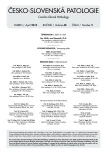-
Medical journals
- Career
Microglial activation and GFAP astroglial immunopositivity in drug abusers
Authors: D. Vajtr 1; J. Kukačka 2; P. Strejc 1; A. Vitouš 3; M. Balíková 1; E. Bradková 1; A. Pilin 1; R. Průša 2
Authors‘ workplace: Ústav soudního lékařství a toxikologie VFN a 1. LF UK, Praha 1; Ústav klinické biochemie a patobiochemie FN Motol a 2. LF UK, Praha 2; Klinika infekčních nemocí FN Motol a 2. LF UK, Praha 3
Published in: Soud Lék., 57, 2012, No. 2, p. 31-33
Category: Original Article
Overview
Introduction:
The neurotoxicity brought about by application of toxic and psychotropic substances is accompanied by an activation of astroglial and microglial cells in the brain.Materials and method:
We investigated clinically 42 patients addicted to psychotropic substances (hospitalised in the Motol Teaching Hospital). The NSE, S1OOB, and manganese concentrations in the blood were measured in the patients. In 14 deceased patients with drug evidence in the hair indicating a chronic abuse of addictive substances, the brain tissue glial cells were immunohistochemically labelled with antibody against CD68 and GFAP.Results:
In 8 hospitalised patients, there were increased NSE, S100B values in the blood (p < 0.05). Manganese in the blood was increased (3,03±1,9 μg/l, p < 0,05) in all patients. In deceased persons, the CD68 positivity of microglial cells and neurophagy have been proved. GFAP positive astroglial cells have been evidenced in the gray and white matter.Conclusion:
The CD68 and GFAP positive glial cells in brain tissue can be a pathomorphological correlate of neurotoxicity in chronic abusers. The neurotoxicity can be monitored with NSE and S100B markers of damaged neuronal cells.Keywords:
neurotoxicity – mikroglial cells – astroglial cells – neuron specific enolasis – S-100B protein
Sources
1. Kiyatkin EA, Brown PL, Sharma HS. Brain edema and breakdown of the blood-brain barrier during methamphetamine intoxication: critical role of brain hyperthermia. Eur J Neurosci 2007; 26(5): 1242–53.
2. Sharma HS, Kiyatkin EA. Rapid morphological brain abnormalities during acute methamphetamine intoxication in the rat: an experimental study using light and electron microscopy. J Chem Neurovnat 2009; 37(1): 18–32. Epub 2008 Aug 19.
3. Kim HC, Jhoo WK, Kim WK, et al. An Immunocytochemical study of mitochondrial manganese-superoxide dismutase in the rat hippocampus after kainate administration. Neurosci Lett 2000; 281(1): 65–68.
4. Bruce-Keller AJ, Turchan-Cholewo J, Smart EJ, et al. Morphine causes rapid increases in glial activation and neuronal injury in the striatum of inducible HIV-1 Tat transgenic mice. Glia 2008; 56(13): 1414–1427.
5. Kimura T, Budka H. Glial fibrillary acidic protein and S-100 protein in human hepatic encephalopathy: immunocytochemical demonstration of dissociation of two glia-associated proteins. Acta Neuropathol 1986; 70(1): 17–21.
6. Kril JJ, Flowers D, Butterworth RF. Distinctive pattern of Bergmann glial pathology in human hepatic encephalopathy. Mol Chem Neuropathol 1997; 31(3): 279–287.
7. Balíková M a kol. Hair analyses for drug abuse and forensic applications. Chemické listy 101 (S), 2007, s84–s87.
8. Balíková M. Klinická a forenzní toxikologie, Galén 2007 Praha (ISBN 978-80-7262-284-9).
9. Balíková M. Hair analysis for drugs of abuse. Plausibility of interpretation. Biomed. Pap. Med. Fac. Univ. Palacky Olomouc Czech Repub. 2005, 149 (2):199–207.
10. Pragst F, Balíková M. State of the art in hair analysis for detection of drug and alcohol abuse. Clin Chim Acta 2006; 370 : 17–49.
Labels
Anatomical pathology Forensic medical examiner Toxicology
Article was published inForensic Medicine

2012 Issue 2
Most read in this issue- Presentation of eponymous terms in forensic medicine
- Unattended fatal haemorrhage associated with spontaneous rupture of peripheral varicosity
- Frangible bullets: wounding capability and clinical aspects of their use
- Microglial activation and GFAP astroglial immunopositivity in drug abusers
Login#ADS_BOTTOM_SCRIPTS#Forgotten passwordEnter the email address that you registered with. We will send you instructions on how to set a new password.
- Career

